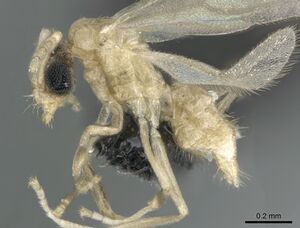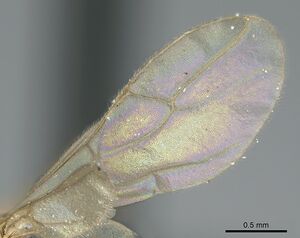Paraparatrechina illusio
| Paraparatrechina illusio | |
|---|---|

| |
| Scientific classification | |
| Kingdom: | Animalia |
| Phylum: | Arthropoda |
| Class: | Insecta |
| Order: | Hymenoptera |
| Family: | Formicidae |
| Subfamily: | Formicinae |
| Tribe: | Lasiini |
| Genus: | Paraparatrechina |
| Species: | P. illusio |
| Binomial name | |
| Paraparatrechina illusio LaPolla & Fisher, 2014 | |
Collected from forest and coastal scrub habitats.
Identification
LaPolla and Fisher (2014) - Short, decumbent pubescence present lateroanteriorly around eyes; pubescence on gaster shorter, tightly appressed to gaster, with pubescence appearing in neat rows with a silky appearance.
Compare with: Paraparatrechina gnoma, Paraparatrechina oreias, and Paraparatrechina subtilis. This species falls into the small, yellow Paraparatrechina worker phenotype range (typically workers of these species vary by only slight difference in setation and color tones of yellow and brownish-yellow) and therefore identification of the species can be difficult. It is morphological similar to three Aftrotropical species: P. gnoma, P. oreias, and P. subtilis. In practice, a relatively straight forward, nonmorphological way, to separate P. illusio is it is only known from the Seychelles, while the remaining three species are from West and Central Africa. Morphologically, it differs from P. gnoma in being slightly larger overall and in coloration (P. gnoma is brownish-yellow with lighter yellow patches). From P. oreias the main difference also lies in color. The gaster of P. oreias is brownish-yellow, contrasting slightly with the remainder of the body. The metanotal area of P. oreias is also more distinctly defined than is seen in P. illusio. From P. subtilis, the difference is in the pubescence. Whereas the pubescence on the head of P. subtilis is decumbent throughout, on P. illusio it is only decumbent lateroanteriorly around eyes. Additionally the gastral pubescence is different between the two: in P. subtilis it is longer and slightly decumbent, contrasting with the shorter, tightly appressed pubescence observed in P. illusio.
Keys including this Species
Distribution
Latitudinal Distribution Pattern
Latitudinal Range: -4.28364° to -4.66311°.
| North Temperate |
North Subtropical |
Tropical | South Subtropical |
South Temperate |
- Source: AntMaps
Distribution based on Regional Taxon Lists
Malagasy Region: Seychelles (type locality).
Distribution based on AntMaps
Distribution based on AntWeb specimens
Check data from AntWeb
Countries Occupied
| Number of countries occupied by this species based on AntWiki Regional Taxon Lists. In general, fewer countries occupied indicates a narrower range, while more countries indicates a more widespread species. |

|
Estimated Abundance
| Relative abundance based on number of AntMaps records per species (this species within the purple bar). Fewer records (to the left) indicates a less abundant/encountered species while more records (to the right) indicates more abundant/encountered species. |

|
Biology
Castes
Images from AntWeb
 
| |
| Holotype of Paraparatrechina illusio. Worker. Specimen code casent0159099. Photographer Estella Ortega, uploaded by California Academy of Sciences. | Owned by CAS, San Francisco, CA, USA. |
      
| |
| Male (alate). Specimen code casent0159242. Photographer Estella Ortega, uploaded by California Academy of Sciences. | Owned by CAS, San Francisco, CA, USA. |
    
| |
| Queen (alate/dealate). Specimen code casent0160097. Photographer Estella Ortega, uploaded by California Academy of Sciences. | Owned by CAS, San Francisco, CA, USA. |
     
| |
| Male (alate). Specimen code casent0914145. Photographer Michele Esposito, uploaded by California Academy of Sciences. | Owned by CAS, San Francisco, CA, USA. |
Nomenclature
The following information is derived from Barry Bolton's Online Catalogue of the Ants of the World.
- illusio. Paraparatrechina illusio LaPolla & Fisher, 2014: 142, figs. 1-9 (w.q.m.) SEYCHELLES.
Unless otherwise noted the text for the remainder of this section is reported from the publication that includes the original description.
Description
Worker
(n=8) TL: 1.20–1.67; HW: 0.35–0.38; HL: 0.39–0.42; EL: 0.10–0.11; SL: 0.37–0.40; PW: 0.23–0.26; WL: 0.41–0.44; GL: 0.39–0.81 Indices: CI: 86-95; REL: 25-27; SI: 101-112.
Yellow to brownish-yellow; legs and antennae lighter; short, decumbent pubescence present lateroanteriorly around eyes; pubescence on gaster short, tightly appressed to gaster, with pubescence appearing in neat rows with a silky appearance. Head subquadrate with nearly straight posterior margin; scapes surpass posterior margin by first 2-3 funicular segments; three ocelli apparent. Mesosoma compact with steeply rising pronotum in lateral view; metanotal area indistinct, only slightly impressed; propodeum with short, flat dorsal face and much longer, steep declivitous face.
Queen
Measurements (n=3) TL: 2.92–3.23; HL: 0.54–0.55; HW: 0.58–0.61; EL: 0.20–0.21; SL: 0.53–0.53; PW: 0.62–0.66; WL: 0.97–1.03; GL: 1.34–1.70 Indices: CI: 110-111; REL: 36-38; SI: 86-88
As in worker, with modifications expected for queen caste and the following differences:
1. Pubescence distinctly across head and mesosoma.
2. Gaster darker (yellowish-brown) than remainder of body.
Male
Measurements (n=1) TL: 1.55; HL: 0.33; HW: 0.38; EL: 0.18; SL: 0.31; PW: 0.29; WL: 0.54; GL: 0.68 Indices: CI: 113; REL: 53; SI: 81
Head brown, with bulging large eyes that occupy most of the lateral region of the head; head slightly broader than long. Palps distinctly lighter than head in color. A dense layer of pubescence covers head, with scattered erect setae along mid-region, posterior margin and clypeus. Scapes surpass posterior margin by about length of the first 2 funicular segments; antennae 13-segmented. Mandible with apical tooth and an indistinct basal angle. Mesosoma same color as head; pronotum short and collar-like; mesonotum large, rounded anteriorly, overarching pronotum; mesosoma dorsum flat, with erect setae. Gaster slightly ligher brown than head and mesosoma, covered with pubescence and erect setae. Parameres relatively broad then with a steep angle towards last third of paramere length; last third of paramere thinner and elongated with rounded apex; paramere with scattered erect setae.
Type Material
Holotype worker. SEYCHELLES: Praslin Island, 280m, 4.34725°S, 55.74743°E, 6.ii.2010, mixed palm forest, on low vegetation, B.L. Fisher et al. CASENT0159099 (California Academy of Sciences); 5 paratype workers, SEYCHELLES: Conception Island, 65 m, 4.66311°S, 55.36821°E, 12.ii.2010, mixed forest, B.L. Fisher et al. CASENT0160297 (CASC), CASENT0160331 (CASC), CASENT0160622 (National Museum of Natural History), CASENT0160625 (CASC), CASENT0160650 (CASC); paratype worker, SEYCHELLES: Curieuse Island, 5 m, 4.28364°S, 55.7269°E, 4.ii.2010, coastal scrub, B.L. Fisher et al. CASENT0160122 (CASC); paratype worker, SEYCHELLES: Praslin Island, Newcome, 130m, 4.390°S, 55.6926°E, 6.ii.2010, palm forest, B.L. Fisher et al. CASENT0158991 (USNM); paratype worker, SEYCHELLES: Sillhouette Island, 20 m, 4.49076°S, 55.25341°E, 21.i.2010, coastal scrub, B.L. Fisher et al., CASENT0159838 (CASC).

